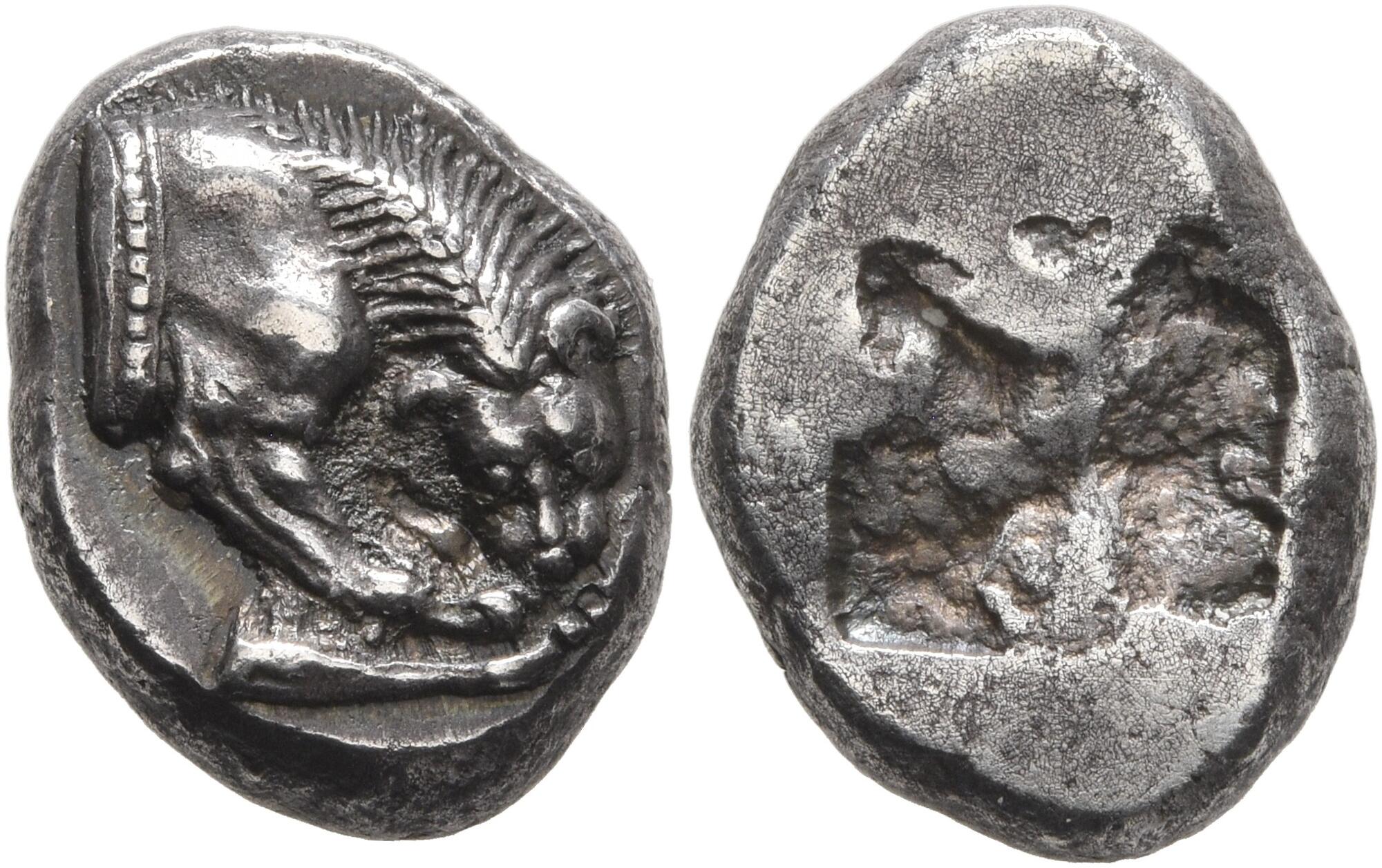Velia, silver, drachms (535-465 BCE)
From SILVER
535 BCE - 465 BCE Silver 5,004 kg
Description
| ObverseInscription or printing placed on the obverse.: | Forepart of lion r., tearing stag's leg. |
| ReverseInscription or printing placed on the reverse.: | Quadripartite incuse square. |
Mint and issuing power
| MintIdentifies the place of manufacture or issue of a numismatic object.: | Velia | Ancient regionAncient region.: | Lucania | Modern countryModern country: Italy | AuthorityIdentifies the issuing power. The authority can be "pretended" when the name or the portrait of X is on the coin but he/she was not the issuing power. It can also be "uncertain" when there is no mention of X on the coin but he/she was the issuing power according to the historical sources: |
Chronology
| FromIdentifies the initial date in a range assigned in a numismatic context. | 535 BCE | toIdentifies the final date in a range assigned in a numismatic context.. | 465 BCE | PeriodTime period of the numismatic object.: Archaic and Classical |
Physical description
| MetalThe physical material (usually metal) from which an object is made.: | Silver |
Median weightMedian of the weights of numismatic objects (in grams). in grams | 3.80 | DenominationTerm indicating the value of a numismatic object. Examples: tetradrachm, chalkous, denarius.: | drachma |
StandardStandard.: |
Image

AC 10 - Velia, silver, drachma, 535-465 BC.jpg [1]
References
| Die study referencePublication of the study: | Williams 19921Williams 1992, Groupe I: variétés 1-69 (D1-D52 et R1-R48). | ||
| Coin series referenceReference to coin series study: | Sear I2Sear I, n° 249, RQEMAC3RQEMAC, n° 10, HN Italy4HN Italy, n° 1259 | ||
Obverse dies distribution
| FrequencyFrequency of specimen in distribution. ᵖ | Number of obversesNumber of obverse dies. ᵖ (o) | % (o) | Number of coinsNumber of coins. (n) | % (n) | Die nameName(s) of the die(s). |
| 1 | 28 | 53.85 | 28 | 17.83 | 3, 17, 19, 21, 23, 24, 26, 27, 28, 30, 31, 34, 35, 37, 38, 40, 41, 42, 44, 45, 46, 47, 48, 49, 50, 51, 52 |
| 2 | 12 | 23.08 | 24 | 15.29 | 4, 11, 13, 14, 15, 22, 26, 32, 33, 36, 39, 43 |
| 3 | 3 | 5.77 | 9 | 5.73 | 12, 18, 29 |
| 5 | 3 | 5.77 | 15 | 9.55 | 6, 7, 9 |
| 6 | 1 | 1.92 | 6 | 3.82 | 8 |
| 7 | 1 | 1.92 | 7 | 4.46 | 16 |
| 8 | 1 | 1.92 | 8 | 5.1 | 2 |
| 9 | 1 | 1.92 | 9 | 5.73 | 5 |
| 16 | 1 | 1.92 | 16 | 10.19 | 10 |
| 35 | 1 | 1.92 | 35 | 22.29 | 20 |
| Total | 52 of 52 | 99.99 | 157 of 157 | 99.99 |
Reverse dies distribution
no distribution is available
Quantification
| Number of obversesNumber of obverse dies. ᵖ (o) | 52 | Number of singletons (o1)The number of singleton coins. ᵖ | 28 |
| Number of reverse diesNumber of reverse dies. (r) | 48 | Number of coinsNumber of coins. (n) | 157 |
| Coins per obverse dieNumber of coins per obverse die. (n/o) | 3.02 | Coins per reverse dieNumber of coins per reverse die. (n/r) | 3.27 |
| Reverse per obverse ratioRatio of obverse dies divided by reverse dies. (r/o) | 0.92 | Percentage of singletons (o1)number of coins (n) divided by the number of singletons (o1) ᵖ | 53.85 % |
| Original number of dies (O) (Carter 1983 formula)The estimation of the number of coins according to Carter 1983 ᵖ | 65.84 | Coins struck if 20,000 as average productivity per dieCoins made if the average productivity for obverses (according to Carter) is 20,000. ᵖ | 1,316,800 |
| Original number of dies (O) (Esty 2011 formula)The estimation of the number of coins according to the singleton formula in Esty 2011 ᵖ (O) | 77.75 | Survival rate if 20,000 as average productivity per dieSurvival rate if average productivity is 20,000. ᵖ | 0.00012 |
| Coverage (o = % of O) (Esty 1984 formula)Esty 1984 - coverage (% of O) ᵖ (o = % of O) | 82.17% | Die productivity if survival rate 1/2,000Average productivity if survival rate is 1/2,000. ᵖ | 4,769.14 |
| Weight of silver (in kg) if 20,000 coins per die (O = Carter formula)Carter 1983 * Median weight * 20000 (*10 if gold or electrum) ᵖ | 5,004 kg <br /> 5,004 kg | Die productivity if survival rate 1/5,000Average productivity if survival rate is 1/5,000. ᵖ | 11,922.84 |
Remarks